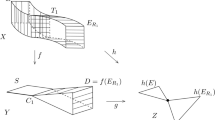Abstract.
When S is a surface with p g (S)>0, Mumford proved that its Chow group A*S is not “finite dimensional” in some sense. In this paper, we propose another definition of “finite dimensionality” for the Chow groups. Using this new definition, at least the Chow group of some surface S with p g (S)>0 (for example, the product of two curves) becomes finite dimensional. The finite dimensionality of the Chow groups follows from the finite dimensionality of the Chow motives. It turns out that the finite dimensionality of the Chow motives is a very strong property. For example, we can prove Bloch’s conjecture (representability of the Chow groups of surfaces with p g (S)=0) under the assumption that the Chow motive of S is finite dimensional.
Similar content being viewed by others
References
André, Y.: Motifs de dimension finie. Séminaire Bourbaki, 2004
Beauville, A.: Sur l’anneau de Chow d’une variété abélienne. Math. Ann. 273, 647–651 (1986)
Bloch, S.: Some elementary theorems about algebraic cycles on abelian varieties. Invent. Math. 37, 215–228 (1976)
Bloch, S., Kas, A., Lieberman, D.: Zero cycles on surfaces with p g =0. Compositio Math. 33, 135–145 (1976)
Deninger, C., Murre, J.: Motivic decomposition of Abelian schemes and the Fourier transform. J. Reine. Angew. Math. 422, 201–219 (1991)
Fulton, W.: Intersection Theory. Springer, Berlin, 1984, pp. xi+470
Fulton, W., Harris, J.: Representation Theory. Springer GTM 129, New York, 1991, pp. xvi+551
Guletskii, V.: A remark on nilpotent correspondences, K-theory preprint archive 651 (2003), http://www.math.uiuc.edu/K-theory
Kimura, S.: Fractional Intersection and Bivariant Theory. Commun. Algebra 20, 285–302 (1992)
Kimura, S.: On Varieties whose Chow Groups have Intersection Products with
 -coefficients. Thesis, University of Chicago, 1990
-coefficients. Thesis, University of Chicago, 1990Kimura, S.: A cohomological characterization of Alexander schemes. Invent. math. 137, 575–611 (1999)
Kimura, S., Vistoli, A.: Chow rings of infinite symmetric products. Duke Math. J. 85, 411–430 (1996)
Kleiman, S.: The standard conjectures. In: Motives (Seattle, WA, 1991). Proc. Sympos. Pure Math. Vol 55, Amer. Math. Soc. pp. 3–20, 1994
Knutson, D.: λ-Rings and the Representation Theory of the Symmetric Group. Lecture Notes in Math. 308, (Springer, Berlin 1973) iv+203 pp
Mazza, C.: Schur functors and motives. K-theory preprint archive 641 (2003), http://www.math.uiuc.edu/K-theory/
Mumford, D.: Rational equivalences of 0-cycles on surfaces. J. Math. Kyoto Univ. 9, 195–204 (1969)
Roitman, A.A.: The torsion of the group of 0-cycles modulo rational equivalence. Ann. Math. 111, 553–569 (1980)
Scwarzenberger, R.L.E.: Jacobians and Symmetric Products. Illinois J. Math. 7, 257–268 (1963)
Shermenev, A.M.: The motive of an abelian variety. Funct. Anal. 8, 47–53 (1974)
Voevodsky, V.: Nilpotence theorem for cycles algebraically equivalent to zero. Internat. Math. Res. Notices pp. 187–198 (1995)
Vistoli, A.: Intersection theory on algebraic stacks and on their moduli spaces. Invent. math. 97, 613–670 (1989)
Author information
Authors and Affiliations
Corresponding author
Additional information
Mathematics Subject Classification (2000): 14C
Rights and permissions
About this article
Cite this article
Kimura, SI. Chow groups are finite dimensional, in some sense. Math. Ann. 331, 173–201 (2005). https://doi.org/10.1007/s00208-004-0577-3
Received:
Published:
Issue Date:
DOI: https://doi.org/10.1007/s00208-004-0577-3




 -coefficients. Thesis, University of Chicago, 1990
-coefficients. Thesis, University of Chicago, 1990